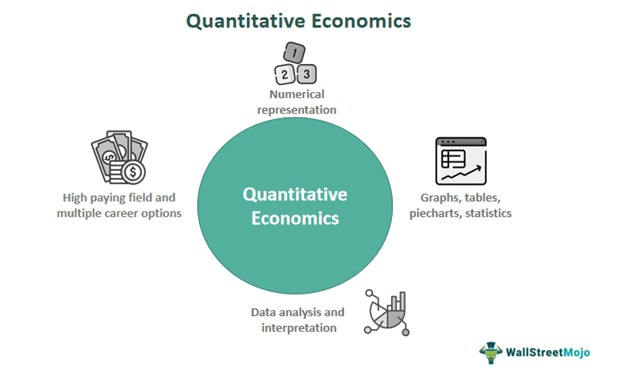Table of Contents
What Is Quantitative Economics?
Quantitative economics refers to the study of markets, economic theories, and policies from the viewpoint of mathematical calculations, statistical analysis, and formulas. It uses values, numbers, and mathematical interpretations to elaborate on the relationship in modern economics. In finance, it provides rigorous techniques for risk management, asset pricing, and financial market analysis.

The study includes important economic factors such as expenditure, income, inflation, money, international trade, population, and balance of payments through the application of mathematics. Mathematics plays an important role in statistical analysis as economists seek mean, median, and mode and may require graphs, charts, and diagrams based on quantitative information.
Key Takeaways
- Quantitative economics is the study of markets, policies, economic theories, and the structure of world economies and structures. This approach uses formulas, statistical methods, numbers, and mathematical interpretations.
- Unlike quantitative economics, qualitative economics deals with social responses, consumption patterns, market behavior, and the decision-making processes of consumers.
- It involves examining economic theories, policies, and factors that are not easily quantifiable.
- This approach makes it easy to prove or test a theory or economic phenomenon through calculation-based values and representations.
Quantitative Economics Explained
Quantitative economics is the study of economics with a primary focus on data collection and analysis. It utilizes mathematical tools, formulas, and statistical calculations to elaborate on factors such as inflation, income, consumption, market trends, imports and exports, population, growth, and other micro and macroeconomic aspects. This approach examines empirical and value-based information to understand the dynamics of the economy comprehensively.
There are three significant steps in quantitative economics jobs. They are listed below:
- Quantification of economic variables - This involves collecting data from various sources and quantifying them directly, such as population. Other variables require analysis, such as income, consumption, expenditure, etc.
- Setting up the sample size - For every analysis, economists must determine the appropriate sample size that fits the study and also accounts for errors. Many opt for standard deviation, whereas others may account for time and cost.
- Data analysis - Once the economists have the data, it can be used to make graphs, tables, and frequency distribution and rank them in the preferred order. It helps economists deduce different market trends, patterns, and other attributes.
However, inaccurate data collection can lead to incorrect results. A large number of variables and the population size have always been a major concern for economists, and sometimes, the determination becomes complex. Despite these challenges, quantitative economics has a critical role in the numerical significance of an economy, market, or financial structure.
Methods
There are three main methods of quantitative economics:
- Econometrics - It helps develop methods of data collection and analysis of nonexperimental economic data, forecasting financial variables, and defining economic theories or phenomena. It includes risk measurement, investment decisions, and the study of individual and collective economic behavior.
- Statistics - This method is centered around the statistical methodologies and techniques of data analysis, including the design, survey, and building of new probability models. It is mostly used in social statistical analysis, parameter estimation, time series analysis, and spatial economics, employing data from multiple sources.
Statistics is a method focused on statistical methodologies and techniques for data analysis, including survey design and the development of probability models. It finds extensive application in social statistical analysis, parameter estimation, time series analysis, and spatial economics, utilizing data from various sources.
- Optimization - In this method, the primary focus is on the theoretical studies and aspects of variational inequalities. It has both vector and scalar model cases. Moreover, it deals with topics such as optimization of the risk-return profile, international market operations, portfolio optimization, and methods related to automated trading systems and stochastic models.
Examples
Here are two examples to help you understand the concept better:
Example #1
Suppose a government wants to study the income of a small town. In 2021, the town had a population of 90000 with an average annual household income of $35190. In 2022, the population grew by 9% and became 98100, while the average income of households declined by 4%, reducing to $33782.4. By 2023, the population grew to 103005, while the average income decreased to $33106.75.
The government can use this data for statistical analysis to understand the relationship between population growth and income and comprehend the town's economy as a whole. At the same time, the data can be represented graphically using pie charts and tables. Similarly, the authorities can study agricultural data, gender ratio, inflation, consumption, sales, interest rates, income patterns, and employment rates, illustrating quantitative economics principles.
Example #2
In September 2023, Augustana University in South Dakota started offering a quantitative economics major alongside its traditional economics program. The faculty believes that the degree places more emphasis on the quantitative side of economics, which mainly includes analyzing situations using models, computer simulations, and empirical analysis.
The curriculum includes seven economics and four math courses with two elective credits. Faculty members anticipate that graduates who are majoring in the field of quantitative economics will possess enhanced analytical skills, enabling them to address real-world challenges in a data-driven manner. They believe this skill set will be highly valued in today's competitive job market.
Quantitative Economics Vs Qualitative Economics
The key differences between qualitative and quantitative economics are listed below:
| Quantitative Economics | Qualitative Economics |
|---|---|
| It is based on numbers, values, formulas, and statistical analysis. | It is the study of theories, observations, interviews, and surveys. |
| It represents data using a mathematical and arithmetic approach. | Qualitative economics discusses consumer behavior, policies, rational buying processes, emotions, moral values, and economic theories. |
| This approach is numerical, and its accuracy is based on the data collected. | Qualitative economics is unstructured and subjective. |
| It helps convert qualitative economic data into figures for analysis. | Quantitative economic data is also used to accept or reject a market trend or change in consumption patterns. |
